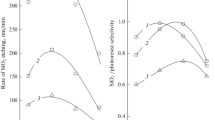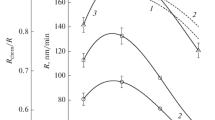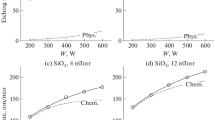Abstract
In this paper, we investigate the kinetics and mechanisms of reactive-ion etching of Si and SiO2 in the plasma of an HBr + O2 mixture with a variable initial composition under conditions of the high-frequency (13.56 MHz) inductive discharge. In the experimental and theoretical (model) analysis of the plasma parameters, the key plasma-chemical processes that form the stationary composition of the gas phase are identified and the densities of active particle fluxes onto the surface under processing are determined. It is found that the increase in the O2 concentration in the plasma-forming mixture is accompanied by a decrease in the kinetic coefficients (probability of effective interaction and etching yield) that characterize the heterogeneous stages of the etching process. It is assumed that the main mechanism of this effect is the oxidation of SiBrx etching products to low volatile compounds of the SiBrxOy type.



Similar content being viewed by others
REFERENCES
Advanced Plasma Processing Technology, New York: Wiley, 2008.
Wolf, S. and Tauber, R.N., Silicon Processing for the VLSI Era, Vol. 1: Process Technology, New York: Lattice Press, 2000.
Nojiri, K., Dry Etching Technology for Semiconductors, Tokyo: Springer Int., 2015.
Coburn, J.W., Plasma Etching and Reactive Ion Etching, AVS Monograph Series, New York: IOP Publ., 1982.
Vitale, S.A., Chae, H., and Sawin, H.H., Silicon etching yields in F2, Cl2, Br2, and HBr high density plasmas, J. Vac. Sci. Technol., A, 2001, vol. 19, no. 5, pp. 2197–2206.
Handbook of Chemistry and Physics, New York: CRC, 2003–2004.
Belen, R.J., Gomez, S., Kiehlbauch, M., and Aydil, E.S., Feature scale model of Si etching in SF6/O2/HBr plasma and comparison with experiments, J. Vacuum. Sci. Technol. A, 2006, vol. 24, no. 2, pp. 350–361.
Tokashiki, K., Ikawa, E., Hashimoto, T., Kikkawa, T., Teraoka, Y., and Nishiyama, I., Influence of halogen plasma atmosphere on SiO2 etching characteristics, Jpn. J. Appl. Phys., 1991, vol. 30, no. 11b, pp. 3174–3177.
Donnelly, V.M., Klemens, F.P., Sorsch, T.W., Timp, G.L., and Baumann, F.H., Oxidation of Si beneath thin SiO2 layers during exposure to HBr/O2 plasmas, investigated by vacuum transfer X-ray photoelectron spectroscopy, Appl. Phys. Lett., 1999, vol. 74, no. 9, pp. 1260–1262.
Cunge, G., Kogelschatz, M., Joubert, O., and Sadeghi, N., Plasma-wall interactions during silicon etching processes in high-density HBr/Cl2/O2 plasmas, Plasma Sources Sci. Technol., 2005, vol. 14, no. 2, pp. S42–S52.
Yeom, G.Y., Ono, Y., and Yamaguchi, T., Polysilicon etchback plasma process using HBr, Cl2, and SF6 gas-mixtures for deep-trench isolation, J. Electrochem. Soc., 1992, vol. 139, no. 2, pp. 575–579.
Kim, D.K., Kim, Y.K., and Lee, H., A study of the role of HBr and oxygen on the etch selectivity and the post-etch profile in a polysilicon/oxide etch using HBr/O2 based high density plasma for advanced DRAMs, Mater. Sci. Semicond. Proc., 2007, vol. 10, no. 1, pp. 41–48.
Lee, B.J., Efremov, A., Kim, J., Kim, C., and Kwon, K.-H., Peculiarities of Si and SiO2 etching kinetics in HBr + Cl2 + O2 inductively coupled plasma, Plasma Chem. Plasma Process., 2019, vol. 39, no. 1, pp. 339–358.
Lee, B.J., Efremov, A., and Kwon, K.-H., Plasma parameters, gas-phase chemistry and Si/SiO2 etching mechanisms in HBr + Cl2 + O2 gas mixture: effect of HBr/O2 mixing ratio, Vacuum, 2019, vol. 163, pp. 110–118.
Son, J., Efremov, A., Yun, S.J., Yeom, G.Y., and Kwon, K.-H., Etching characteristics and mechanism of SiNx films for nano-devices in CH2F2/O2/Ar inductively coupled plasma: effect of O2 mixing ratio, J. Nanosci. Nanotechnol., 2014, vol. 14, pp. 9534–9540.
Shun’ko, E.V., Langmuir Probe in Theory and Practice, Boca Raton, FL: Universal, 2008.
Kwon, K.-H., Efremov, A., Kim, M., Min, N.K., Jeong, J., and Kim, K., A model-based analysis of plasma parameters and composition in HBr/X (X = Ar, He, B2) inductively coupled plasmas, J. Electrochem. Soc., 2010, vol. 157, no. 5, pp. H574–H579.
Hsu, C.C., Nierode, M.A., Coburn, J.W., and Graves, D.B., Comparison of model and experiment for Ar, Ar/O2 and Ar/O2/Cl2 inductively coupled plasmas, J. Phys. D: Appl. Phys., 2006, vol. 39, no. 15, pp. 3272–3284.
Lieberman, M.A. and Lichtenberg, A.J., Principles of Plasma Discharges and Materials Processing, New York: Wiley, 2005.
Jin, W.D., Vitale, S.A., and Sawin, H.H., Plasma-surface kinetics and simulation of feature profile evolution in Cl2 + HBr etching of polysilicon, J. Vac. Sci. Technol., A, 2002, vol. 20, no. 6, pp. 2106–2114.
Gray, D.C., Tepermeister, I., and Sawin, H.H., Phenomenological modeling of ion-enhanced surface kinetics in fluorine-based plasma-etching, J. Vac. Technol. B, 1993, vol. 11, no. 4, pp. 1243–1257.
Chistophorou, L.G. and Olthoff, J.K., Fundamental Electron Interactions with Plasma Processing Gases, New York: Springer Science, 2004.
Efremov, A., Kim, Y., Lee, H.W., and Kwon, K.-H., A comparative study of HBr-Ar and HBr-Cl2 plasma chemistries for dry etch applications, Plasma Chem. Plasma Process., 2011, vol. 31, no. 2, pp. 259–271.
Efremov, A., Lee, J., and Kwon, K.-H., A comparative study of CF4, Cl2 and HBr + Ar inductively coupled plasmas for dry etching applications, Thin Solid Films, 2017, vol. 629, pp. 39–48.
Funding
This work was carried out as part of a state task for the Scientific Research Institute of System Analysis, Russian Academy of Sciences (fundamental scientific research) on topic no. 0065-2019-0006 “Fundamental and Applied Research in the Field of Subwavelength Holographic Lithography, Physicochemical Processes of Etching 3D Nanometer Dielectric Structures for the Development of Crucial Electronic Component Manufacturing Technologies.”
Author information
Authors and Affiliations
Corresponding author
Additional information
Translated by Yu. Kornienko
Rights and permissions
About this article
Cite this article
Efremov, A.M., Betelin, V.B. & Kwon, KH. Kinetics and Mechanisms of Reactive-Ion Etching of Si and SiO2 in a Plasma of a Mixture of HBr + O2 . Russ Microelectron 49, 379–384 (2020). https://doi.org/10.1134/S1063739720060037
Received:
Revised:
Accepted:
Published:
Issue Date:
DOI: https://doi.org/10.1134/S1063739720060037




